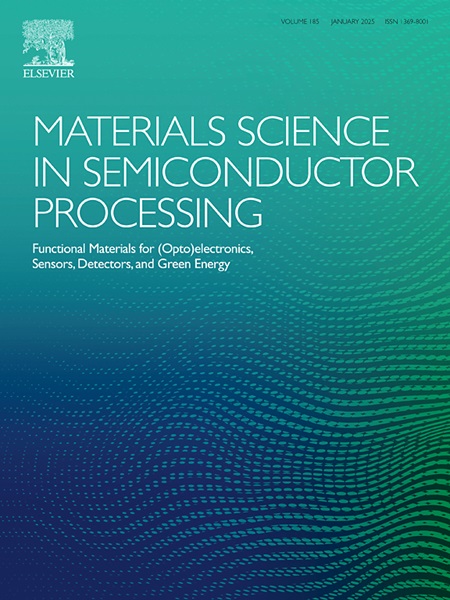制备用于高效光催化降解苯胺蓝和曙红 B 的镍-四胺酞菁-甘蔗髓氧化石墨烯复合材料
IF 4.2
3区 工程技术
Q2 ENGINEERING, ELECTRICAL & ELECTRONIC
引用次数: 0
摘要
本研究利用甘蔗髓制备氧化石墨烯(GO),并将甘蔗髓氧化石墨烯(SPGO)与镍-四胺酞菁(NiTAPc)结合,合成了 NiTAPc-SPGO。通过测量氙灯照射下苯胺蓝(AB)和曙红 B(EB)的光降解情况,评估了 NiTAPc-SPGO 的光催化性能。研究了反应条件对这些染料光催化降解的影响,如黑暗储存条件、有无 H2O2。使用紫外可见光谱、傅立叶变换红外光谱、紫外可见漫反射光谱、X 射线衍射、电化学阻抗光谱和扫描电子显微镜对材料进行了表征。此外,还提出了 NiTAPc-SPGO 介导染料光催化降解的合适机制。结果表明,在 1.5 mL H2O2 的存在下,NiTAPc-SPGO 对 EB(93.32%)和 AB(84.79%)具有较高的降解能力。H2O2 和 NiTAPc-SPGO 具有协同作用,可加快染料的降解程度和速度。在氙灯照射下,NiTAPc-SPGO 中的 NiTAPc 进入激发态,分解成空穴电子对。与 SPGO 相比,NiTAPc-SPGO 复合材料的圆阻抗和电阻率更低,导电性和分离光产生的载流子的能力更强。本文章由计算机程序翻译,如有差异,请以英文原文为准。
Fabrication of nickel-tetramine phthalocyanine-sugarcane pith graphene oxide composites for the efficient photocatalytic degradation of aniline blue and eosin B
In this study, sugarcane pith was used to prepare graphene oxide (GO), and sugarcane pith graphene oxide (SPGO) was bonded to nickel-tetramine phthalocyanine (NiTAPc) to synthesize NiTAPc-SPGO. The NiTAPc-SPGO photocatalytic performance was evaluated by measuring aniline blue (AB) and eosin B (EB) photodegradation under xenon lamp irradiation. The effect of reaction conditions, such as dark storage conditions, with or without H2O2, on the photocatalytic degradation of these dyes was investigated. The materials were characterized using ultraviolet–visible (UV–vis) spectroscopy, Fourier transform infrared spectroscopy, UV–Vis diffuse reflectance spectroscopy, X-ray diffraction, electrochemical impedance spectroscopy, and scanning electron microscopy. Furthermore, a suitable mechanism for the NiTAPc-SPGO-mediated photocatalytic degradation of the dyes was proposed. The results showed that NiTAPc-SPGO had a higher degradation ability for EB (93.32 %) and for AB (84.79 %) in the presence of 1.5 mL H2O2. H2O2 and NiTAPc-SPGO showed synergistic effects, which accelerate the dye's degradation degree and rate. Under xenon lamp irradiation, the NiTAPc in NiTAPc-SPGO turned into the excited state, which disintegrated into hole–electron pairs. The NiTAPc-SPGO composite material showed lower circular impedance and resistivity and enhanced conductivity and ability to separate light-generated carriers than SPGO.
求助全文
通过发布文献求助,成功后即可免费获取论文全文。
去求助
来源期刊

Materials Science in Semiconductor Processing
工程技术-材料科学:综合
CiteScore
8.00
自引率
4.90%
发文量
780
审稿时长
42 days
期刊介绍:
Materials Science in Semiconductor Processing provides a unique forum for the discussion of novel processing, applications and theoretical studies of functional materials and devices for (opto)electronics, sensors, detectors, biotechnology and green energy.
Each issue will aim to provide a snapshot of current insights, new achievements, breakthroughs and future trends in such diverse fields as microelectronics, energy conversion and storage, communications, biotechnology, (photo)catalysis, nano- and thin-film technology, hybrid and composite materials, chemical processing, vapor-phase deposition, device fabrication, and modelling, which are the backbone of advanced semiconductor processing and applications.
Coverage will include: advanced lithography for submicron devices; etching and related topics; ion implantation; damage evolution and related issues; plasma and thermal CVD; rapid thermal processing; advanced metallization and interconnect schemes; thin dielectric layers, oxidation; sol-gel processing; chemical bath and (electro)chemical deposition; compound semiconductor processing; new non-oxide materials and their applications; (macro)molecular and hybrid materials; molecular dynamics, ab-initio methods, Monte Carlo, etc.; new materials and processes for discrete and integrated circuits; magnetic materials and spintronics; heterostructures and quantum devices; engineering of the electrical and optical properties of semiconductors; crystal growth mechanisms; reliability, defect density, intrinsic impurities and defects.
 求助内容:
求助内容: 应助结果提醒方式:
应助结果提醒方式:


